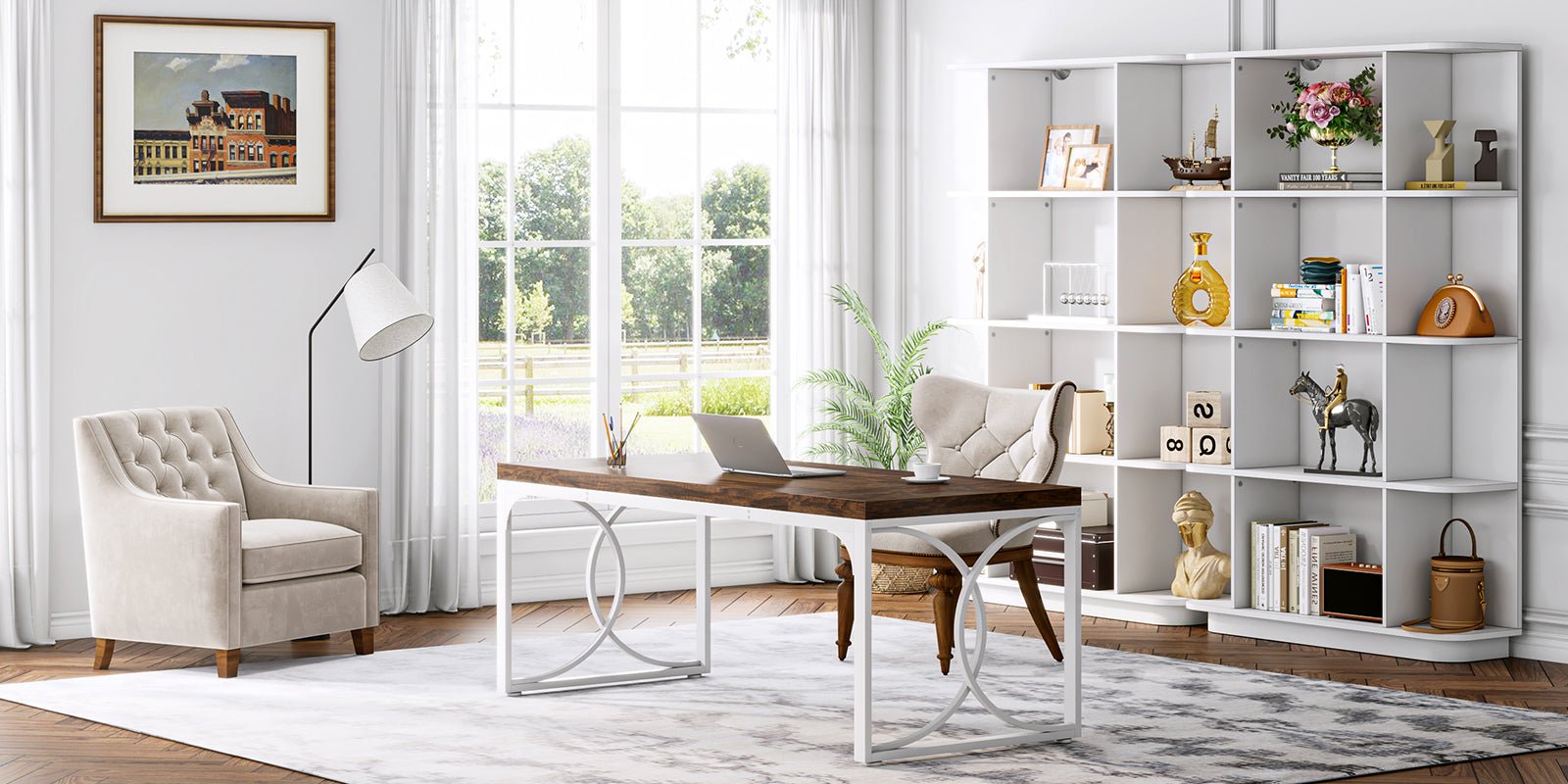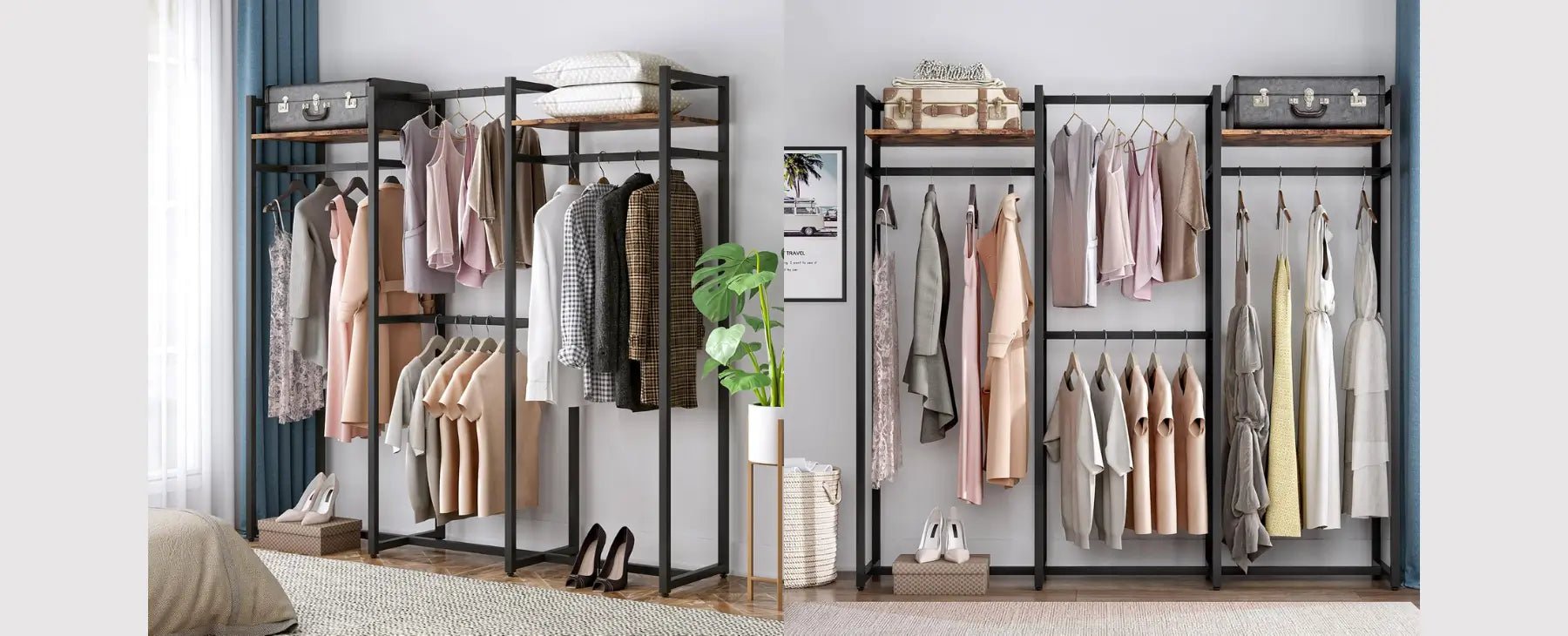Whether you're working from home or in a traditional office, setting up your home office desk the right way is key to boosting productivity, reducing stress, and promoting overall well-being. According to research, a clutter-free workspace not only enhances focus but also leads to improved efficiency and better physical health.
Table of Contents
- 1. Choosing the Right Desk
- 2. Selecting an Ergonomic Chair
- 3. Monitor and Screen Home Office Setup
- 4. Keyboard and Mouse Placement
- 5. Lighting Your Workspace
- 6. Desk Organization and Storage
- 7. Personalizing Your Workspace
- 8. Maintaining an Ergonomic Workflow
- Conclusion: Home Office Set up With Tribesigns
1. Choosing the Right Desk
The desk you choose plays a crucial role in shaping your entire office setup. It serves as the foundation for everything else. When selecting a desk, think beyond its appearance. The right desk should provide ample space, support proper ergonomics, and accommodate all your equipment without overcrowding the space.

Size and Shape
The first factor to consider is the desk size. A standard desk for home office setups typically measures between 48 to 60 inches (122 to 152 cm) in width and 24 to 30 inches (61 to 76 cm) in depth. This size provides enough room for a computer, keyboard, mouse, and a few other essentials like notebooks or a desk lamp. If you use dual monitors, choose a desk at least 60 inches (152 cm) wide to accommodate both comfortably.
For smaller spaces, opt for compact desks around 40 to 48 inches (102 to 122 cm) in width, ideal for a laptop or single monitor setup. If you need more storage or workspace, an L-shaped desk is a great choice, typically ranging from 60 to 72 inches (152 to 183 cm) on each side, maximizing corner space.
Material and Build
The material of your desk affects both its durability and the overall style of your office setup. Popular options include wood, metal, and composite materials. Wooden desks offer warmth and a classic look, while metal desks provide a sleek, industrial aesthetic. For something sturdy yet minimalistic, a metal frame with a solid wood top could be perfect.
Also, consider the build quality. A solidly built desk ensures it will last for years, even with heavy use. Heavier desks typically provide a more stable work surface, making them ideal for long-term office desk setups.
Adjustability
One key feature to look for is adjustability, particularly when it comes to the height of the desk. Height-adjustable desks, also known as sit-stand desks, are increasingly popular for their health benefits. They allow you to alternate between sitting and standing throughout the day, helping to improve posture and reduce the risks associated with prolonged sitting. Many modern desks come with electric or manual height-adjustment mechanisms, making it easy to customize your workspace according to your needs. For ideal ergonomics, the desk height should be adjustable between 28 to 30 inches (71 to 76 cm) from the ground to match your seated position.
2. Selecting an Ergonomic Chair
An ergonomic chair helps support your posture and reduces the risk of back pain, especially during long hours of sitting.
Support Features
Look for a chair with lumbar support to protect your lower back. Adjustable armrests can reduce strain on your shoulders and wrists. Additionally, ensure the chair has seat depth adjustment, so your thighs are fully supported without pressure behind your knees.
Material and Comfort
Breathable fabrics like mesh are ideal for long sitting sessions, as they keep you cool and comfortable. Leather is another good option, but it might be less breathable. Make sure the seat cushion is comfortable but firm enough to prevent sinking too much, which can affect posture.
Fit and Adjustability
Adjustable features are key for an ergonomic chair. Ensure the seat height is adjustable between 16 to 21 inches (41 to 53 cm), allowing your feet to rest flat on the floor. Your elbows should be at a 90-degree angle when using your keyboard. Check the backrest tilt and height to support your spine’s natural curve.

3. Monitor and Screen Home Office Setup
Proper monitor placement is key to preventing neck strain and improving focus, especially when setting up your home office.
Positioning
Your monitor should be about 20 to 30 inches (50 to 75 cm) away from your eyes, roughly at arm's length. The top of the screen should be at or just below eye level to prevent neck strain. If you use multiple monitors, position them in a slight curve around your natural line of sight.
Dual Monitors
If you work with dual monitors, make sure the screens are at the same height and distance. This setup can improve multitasking efficiency. A monitor arm is a great way to adjust the screens to the optimal position and reduce desk clutter.
Anti-Glare Measures
To prevent eye strain, use monitors with anti-glare coatings or position them away from direct light sources. Proper lighting can also make a significant difference—opt for a desk lamp with adjustable brightness to reduce glare and illuminate your workspace without overexposing your eyes.

4. Keyboard and Mouse Placement
The placement of your keyboard and mouse can make a big difference in your comfort and productivity.
Ergonomic Alignment
Your keyboard and mouse should be positioned so your arms are at a comfortable 90-degree angle when typing. Keep your wrists straight, not bent up or down. A keyboard tray can help you achieve this setup, especially if your desk is too high for comfortable typing. Your mouse should be close to your keyboard, allowing you to use both without stretching your arms excessively.
Distance and Height
Your keyboard should be about 2 to 4 inches (5 to 10 cm) above your lap or slightly lower than your elbow height. This ensures your shoulders are relaxed and your forearms are parallel to the floor. Your mouse should be at the same level as the keyboard, and positioned close enough to avoid extending your arm too far.
Alternative Devices
If you experience discomfort with traditional setups, consider ergonomic alternatives such as a split keyboard or a vertical mouse. These devices are designed to reduce wrist strain by allowing a more natural hand position.
5. Lighting Your Workspace
Proper lighting is essential for reducing eye strain and creating a comfortable work environment.
Natural Light
Whenever possible, position your desk near a window to take advantage of natural light. Exposure to natural light can improve your mood and focus, making you more productive. If direct sunlight is too harsh, try using sheer curtains or blinds to diffuse the light.
Task Lighting
A desk lamp with adjustable brightness is a must-have for focused tasks like reading or writing. Opt for lamps with LED bulbs, which are energy-efficient and provide even lighting without producing excessive heat. Make sure the lamp is positioned to illuminate your workspace without causing glare on your screen.
Ambient Lighting
Overhead lighting should complement your desk setup without being too bright or dim. Choose warm lighting to create a comfortable, inviting atmosphere. Avoid harsh fluorescent lights, as they can cause eye fatigue and discomfort.
6. Desk Organization and Storage
A clean, organized desk is key to staying focused and productive. Choose a desk with a hutch, drawers, or shelves, like those from Tribesigns, to keep paper supplies and other essentials neatly stored. You can also use trays or storage boxes to organize small items like pens, paper clips, and sticky notes.
Minimize clutter by keeping only the necessities on your desk, such as your computer, notebook, and a few personal items. Store anything else—like pens, papers, and office supplies—in drawers or shelves to reduce distractions.
One of the biggest sources of desk clutter is cables. Use cable organizers or clips to keep cords in place and out of sight. Cable sleeves or covers can help tidy up power cords, ensuring a clean, clutter-free workspace.

7. Personalizing Your Workspace
Making your workspace feel inviting and personal can boost your mood and productivity. Adding personal touches doesn’t just improve aesthetics; it creates an environment where you feel comfortable and inspired.
Decor Elements
A few well-chosen decor items can make a big difference. Consider adding plants, artwork, or family photos to your desk or surrounding area. Greenery, such as small indoor plants or succulents, can bring life to your workspace while improving air quality.
Color Psychology
The colors you choose can influence your mood and productivity. Soft blues and greens are known to promote calm and focus, while brighter colors like yellow can inspire creativity. Choose colors that align with the atmosphere you want to create, whether it's relaxing or motivating.
Inspiration
Personalize your space with objects that inspire you. Whether it’s a favorite quote, a meaningful memento, or a piece of artwork, incorporating items that reflect your personality can make your workspace more enjoyable and motivating.

8. Maintaining an Ergonomic Workflow
Good posture is essential for comfort and health. Sit with your back straight, shoulders relaxed, and feet flat on the floor. Your monitor should be at eye level, and your arms should be at a 90-degree angle when typing. If you start to feel uncomfortable, adjust your setup to maintain proper posture.
Make a habit of standing up, stretching, or walking around every 30 to 60 minutes. Use an adjustable sit-stand desk to alternate between sitting and standing positions, which can help reduce fatigue and improve blood circulation.
Read more: Desk vs Table: What is the Difference?
Conclusion: Home Office Set Up With Tribesigns
Setting up the home office desk isn’t just about functionality—it’s about creating a space that boosts your productivity and comfort. With the right desk, ergonomic features, and personal touches, you can transform your workspace into a place that works for you.
Tribesigns' uniquely designed furniture offers the ideal solution. Whether you’re looking for a spacious desk, a height-adjustable option, or a sleek, minimalist style, we have the perfect piece to fit your space. Discover the perfect desk today and create a workspace that supports your best work.
Make your office work for you with Tribesigns!



